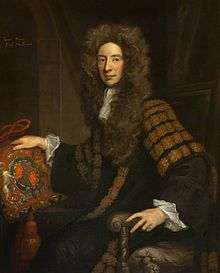Patrick Hume, 1st Earl of Marchmont
| The Earl of Marchmont | |
|---|---|
 Portrait by Godfrey Kneller. | |
| Lord Chancellor of Scotland | |
|
In office 1696–1702 | |
| Monarch | William II |
| Preceded by | The Marquess of Tweeddale |
| Succeeded by | The Earl of Seafield |
| Personal details | |
| Born |
13 January 1641 Polwarth, Berwickshire, Scotland |
| Died |
2 August 1724 (aged 83) Berwick-on-Tweed, Great Britain |
| Resting place | Canongate Kirkyard, Edinburgh |
| Spouse(s) | Grizel Ker |
| Children |
4 sons 5 daughters |
| Alma mater | University of Paris |
| Religion | Presbyterian |
| Military service | |
| Battles/wars |
Argyll's Rising Glorious Revolution |
Patrick Hume, 1st Earl of Marchmont (13 January 1641 – 2 August 1724), known as Sir Patrick Hume, 2nd Baronet from 1648 to 1690 and as Lord Polwarth from 1690 to 1697, was a Scottish statesman. His grandfather was the poet and courtier Sir Patrick Hume of Polwarth and Redbraes who died in 1609.
Life
Born at Polwarth, Berwickshire, he was raised as a strict Presbyterian, and after a term of law study at Paris he represented his native country in Parliament, where he at once took a foremost place as defender of the Covenanters. He went so far as to bring imprisonment upon himself, and on being freed was suspected of complication in the Rye House Plot, so that he was forced to remain in hiding until he could escape in disguise to the Continent. There he joined Archibald Campbell, 9th Earl of Argyll and embarked with him on the unsuccessful 1685 expedition to Scotland. Hume became a refugee with a price set upon his head; but he once more escaped abroad and lived at Utrecht under the name "Dr. Wallace," professing to be a Scottish surgeon. He returned with William of Orange at the Revolution of 1688.
With estates restored, he was now a Scottish peer, Lord Polwarth; was made Lord Chancellor in 1696 and Earl of Marchmont in 1697. He strenuously opposed in Parliament the claims of the Old Pretender to the crown and voted for the union of Scotland with England, though he was not above the suspicion of having received a reward for so doing. Too dogmatic to be popular, he did not hold office in the United Kingdom till the reign of George I, when he was given some minor charges, but shortly retired.
References
-
 This article incorporates text from a publication now in the public domain: Gilman, D. C.; Thurston, H. T.; Colby, F. M., eds. (1905). "article name needed". New International Encyclopedia (1st ed.). New York: Dodd, Mead.
This article incorporates text from a publication now in the public domain: Gilman, D. C.; Thurston, H. T.; Colby, F. M., eds. (1905). "article name needed". New International Encyclopedia (1st ed.). New York: Dodd, Mead. - Leigh Rayment's Peerage Pages
 Lee, Sidney, ed. (1891). "Hume, Patrick (1641-1724)". Dictionary of National Biography. 28. London: Smith, Elder & Co.
Lee, Sidney, ed. (1891). "Hume, Patrick (1641-1724)". Dictionary of National Biography. 28. London: Smith, Elder & Co.
| Political offices | ||
|---|---|---|
| Preceded by The Marquess of Tweeddale |
Lord Chancellor of Scotland 1696–1702 |
Succeeded by The Earl of Seafield |
| Peerage of Scotland | ||
| Preceded by New Creation |
Earl of Marchmont 1697–1724 |
Succeeded by Alexander Hume-Campbell |
| Baronetage of Nova Scotia | ||
| Preceded by Patrick Hume |
Baronet (of Polwarth) 1648–1724 |
Succeeded by Alexander Hume-Campbell |